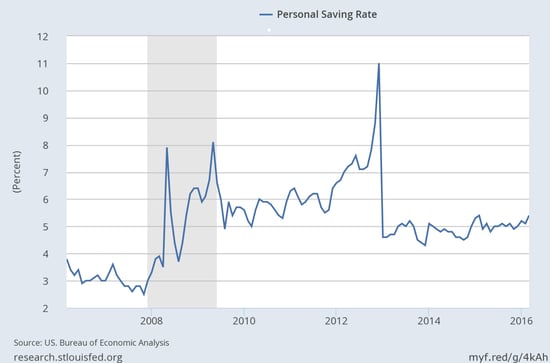 After yesterday’s discussion of wage growth, today’s data on consumer spending and confidence makes for a good follow-up.
After yesterday’s discussion of wage growth, today’s data on consumer spending and confidence makes for a good follow-up.
Consumers: saving now to spend later?
I closed yesterday’s post with a comment on money illusion—the disconnect that inflation creates between actual spending power and nominal income. The higher the inflation, the bigger the “raise” you might get but the less you can actually increase your spending.
Arguably, this has been a major cause of slow consumer spending growth. Over the past several years—when, based on history, spending might have been expected to rise in line with income growth—consumers have diverted much of that income into savings instead.
As you can see below, the savings rate spiked after the financial crisis, then fell to about 4.5 percent when the recovery seemed to be gaining traction in 2013. Recently, it’s moved back up to about 5.5 percent, with much of the increase coming during the slowdown of the past couple of quarters, as people got worried.

The focus on saving has certainly slowed growth in the short term. But the idea that it somehow compromises growth in the long term seems kind of silly. By paying down debt and saving, consumers are laying a firmer foundation for the future. By not spending now, they are ensuring that they will be able to spend more later. In other words, short-term pain is paving the way for longer-term gains.
Another way to look at it is to consider the difference between not being able to spend more and not choosing to spend more. In past episodes of slow spending growth, consumers haven’t been able to spend. Now they can, but aren’t—a big difference.
And now for today’s data . . .
Retail sales. After several months of weakness, retail sales saw a massive bounce back this morning. The headline number was up by 1.3 percent, well above expectations for a strong 0.8-percent gain. Stripping out the more volatile components, including gas, autos, and building supplies, sales jumped by 0.9 percent, the biggest increase in two years and tripling expectations for a 0.3-percent gain. The research consultancy Capital Economics called the increase in core sales “almost unbelievable.”
Beyond the extremely strong April numbers, both the February and March figures got upward revisions, which brought the three month-on-three month growth level up to almost 4 percent, from 2.8 percent. These significant improvements suggest that the American consumer isn’t dead just yet. They also add to evidence that growth in the first quarter was better than the initial estimate suggests, and that the second quarter is likely to be better yet.
Consumer confidence. One of the major consumer confidence measures, the University of Michigan survey, also rose, from 89.0 to 95.8, reversing several months of declines and moving back to an 11-month high. Confidence rebounded despite the increase in gas prices, an indication that the recovery is solid. Expectations moved up by even more, also suggesting that growth might accelerate.
Overall, today’s strong reports show that consumers can indeed spend if they want to. We shouldn’t rely on one month of data, but after several months of weakness, this is a good reminder that the foundations remain solid, even if growth is slower than we'd like.


 Print
Print

